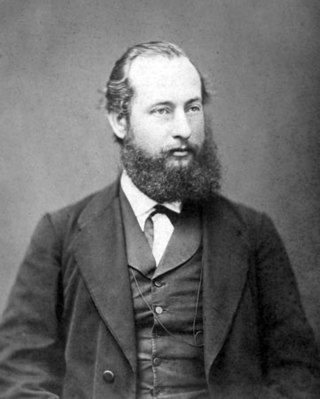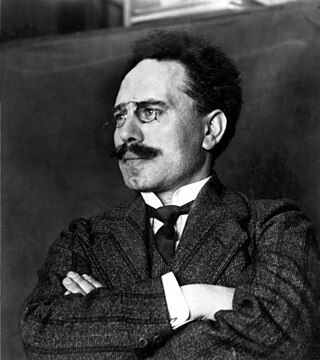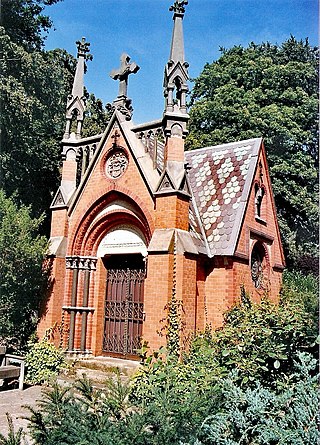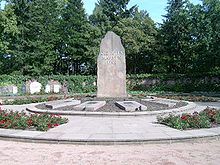
The Vienna Central Cemetery is one of the largest cemeteries in the world by number of interred, and is the most well-known cemetery among Vienna's nearly 50 cemeteries. The cemetery's name is descriptive of its significance as Vienna's biggest cemetery, not of its geographic location, as it is not in the city center of the Austrian capital, but on the southern outskirts, in the outer city district of Simmering.

Friedrich Wilhelm Reinhold Pieck was a German communist politician who served as the chairman of the Socialist Unity Party from 1946 to 1950 and as president of the German Democratic Republic from 1949 to 1960.

Wilhelm Martin Philipp Christian Ludwig Liebknecht was a German socialist and one of the principal founders of the Social Democratic Party of Germany (SPD). His political career was a pioneering project combining Marxist revolutionary theory with practical legal political activity. Under his leadership, the SPD grew from a tiny sect to become Germany's largest political party. He was the father of Karl Liebknecht and Theodor Liebknecht.

The Friedrichsfelde Central Cemetery is a cemetery in the borough of Lichtenberg in Berlin. It was the cemetery used for many of Berlin's Socialists, Communists, and anti-fascist fighters.

The Kremlin Wall Necropolis is the former national cemetery of the Soviet Union, located in Red Square in Moscow beside the Kremlin Wall. Burials there began in November 1917, when 240 pro-Bolsheviks who died during the Moscow Bolshevik Uprising were buried in mass graves. The improvised burial site gradually transformed into the centerpiece of military and civilian honor during the Second World War. It is centered on Lenin's Mausoleum, initially built in wood in 1924 and rebuilt in granite in 1929–30. After the last mass burial in Red Square in 1921, funerals there were usually conducted as state ceremonies and reserved as the final honor for highly venerated politicians, military leaders, cosmonauts, and scientists. In 1925–1927, burials in the ground were stopped; funerals were now conducted as burials of cremated ash in the Kremlin wall itself. Burials in the ground resumed with Mikhail Kalinin's funeral in 1946.

Konrad Wolf was an East German film director. He was the son of writer, doctor and diplomat Friedrich Wolf, and the younger brother of Stasi spymaster Markus Wolf. "Koni" was his nickname.

Leo Fränkel 25 February 1844, Altofen-Neustift, Austro-Hungarian Empire – 29 March 1896, Paris) was a socialist revolutionary, labour leader of Jewish descent. In France where he participated in the Paris Commune of 1871 as a member of the International and after his return to Paris in 1889, he was known as Léo Frankel.

The Invalids' Cemetery is one of the oldest cemeteries in Berlin. It was the traditional resting place of the Prussian Army, and is regarded as particularly important as a memorial to the German Wars of Liberation of 1813–15.

Wilhelm Hasenclever was a German politician. He was originally a tanner by trade but later became a journalist and author. However, he is most known for his political work in the predecessors of the Social Democratic Party of Germany (SPD).

The Döbling Cemetery is a cemetery in the 19th district of Döbling in Vienna, Austria.

The Dorotheenstadt Cemetery, officially the Cemetery of the Dorotheenstadt and Friedrichswerder Parishes, is a landmarked Protestant burial ground located in the Berlin district of Mitte which dates to the late 18th century. The entrance to the 1.7-hectare (4.2-acre) plot is at 126 Chaussee Straße. It is also directly adjacent to the French cemetery, established in 1780, and is sometimes confused with it.
The Association of Revolutionary Visual Artists of Germany was an organization of artists who were members of the Communist Party of Germany. Known primarily by its shortened name, "Asso", it was founded in March 1928. The organization produced posters, placards, propaganda graphics for Communist organizations.

Ancient Greek funerary practices are attested widely in literature, the archaeological record, and in ancient Greek art. Finds associated with burials are an important source for ancient Greek culture, though Greek funerals are not as well documented as those of the ancient Romans.

Karl Paul August Friedrich Liebknecht was a German revolutionary socialist and anti-militarist. A member of the Social Democratic Party of Germany (SPD) beginning in 1900, he was one of its deputies in the Reichstag from 1912 to 1916, where he represented the left-revolutionary wing of the party. In 1916 he was expelled from the SPD's parliamentary group for his opposition to the Burgfriedenspolitik, the political truce between all parties in the Reichstag while the war lasted. He twice spent time in prison, first for writing an anti-militarism pamphlet in 1907 and then for his role in a 1916 antiwar demonstration. He was released from the second under a general amnesty three weeks before the end of the First World War.

The Tomb of Karl Marx stands in the Eastern cemetery of Highgate Cemetery, North London, England. It commemorates the burial sites of Marx, of his wife, Jenny von Westphalen, and other members of his family. Originally buried in a different part of the Eastern cemetery, the bodies were disinterred and reburied at their present location in 1954. The tomb was designed by Laurence Bradshaw and was unveiled in 1956, in a ceremony led by Harry Pollitt, the General Secretary of the Communist Party of Great Britain, which funded the memorial.

The Hauptfriedhof in Karlsruhe is one of the oldest German communal rural cemeteries. In 1871, the first plans to build a new burial ground outside the city center began. The cemetery was laid out in 1874 by Josef Durm in the Rintheim district, east of the actual city, after the inner-city Alter Friedhof Karlsruhe in the Oststadt had become too small. The main cemetery has grown from its original size of 15.3 hectares in 1873 to over 34 hectares. The graves of more than 32,000 deceased are currently in the cemetery.

Maxim Zetkin was a German politician and surgeon.

Burgtor Cemetery or Burgtorfriedhof, originally the Allgemeine Gottesacker, is the successor to other cemeteries in Burgtor, Lübeck suburb of St. Gertrud. It was officially opened in 1834 and today covers an area of around eight hectares and around 8700 burial sites.

Peter Schieder was an Austrian politician of the Socialist Party of Austria (SPÖ) and Chairman of the Socialist Youth Austria (SJÖ).

The Cemetery of the March Fallen is a cemetery in Volkspark Friedrichshain in the Berlin district of Friedrichshain. It was laid out for the victims of the March Revolution of March 18, 1848, the March Fallen. In 1925, the Berlin architect Ludwig Hoffmann redesigned the park and gave it its existing three-sided shape. Further redesigns took place in 1948 and 1957.





















